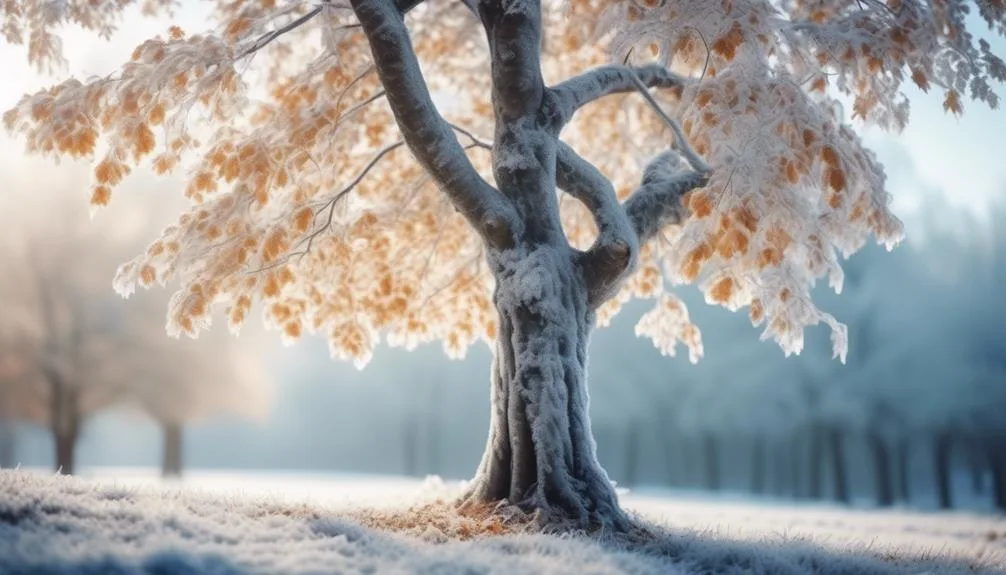Beech trees, known for their beauty and abundant leaves, raise the question: can they withstand frost?
Understanding the factors affecting their frost tolerance is essential for arborists and nature lovers.
Let's explore the relationship between beech trees and frost, and uncover the secrets of their resilience.
Beech Trees and Frost Tolerance
Understanding how beech trees tolerate frost is essential for their successful cultivation and maintenance in varying climates. Beech tree adaptations play a crucial role in their ability to withstand freezing temperatures.
One of the most remarkable winter survival strategies of beech trees is their ability to retain leaves throughout winter. This adaptation helps them continue photosynthesis during milder winter days, providing essential nutrients for survival.
Additionally, beech trees have evolved to protect their delicate buds from frost damage. Their buds are covered in specialized scales that provide insulation and protection from extreme cold.
Furthermore, the trees have developed a deep and extensive root system that allows them to access water even when the ground is frozen.
These adaptations collectively enable beech trees to thrive in diverse climates and endure the challenges of frosty winters.
Factors Affecting Beech Tree Frost Tolerance
To enhance your understanding of beech tree frost tolerance, consider the various environmental and genetic factors that contribute to their ability to withstand freezing temperatures.
- Environmental Conditions: Beech trees' tolerance to frost is influenced by factors such as soil moisture, air temperature, and exposure to sunlight. Adequate soil moisture can help insulate the roots, while lower air temperatures and reduced sunlight exposure can increase the likelihood of frost damage.
- Genetic Adaptation: The genetic makeup of beech trees plays a crucial role in their frost tolerance. Some trees may have developed genetic adaptations that enable them to withstand colder temperatures or recover more effectively from frost damage.
- Microclimate: The specific microclimate where beech trees are located can significantly impact their frost tolerance. Sheltered locations or areas with less temperature fluctuation may provide better conditions for beech trees to endure frost events.
Signs of Frost Damage in Beech Trees
Frost damage can manifest in beech trees as wilting, browning of leaves, and the appearance of water-soaked spots on the foliage. When frost sets in, the leaves may become limp and start to turn brown at the edges, eventually spreading throughout the leaf. Water-soaked spots may also appear, indicating cellular damage caused by freezing temperatures.
To mitigate frost damage, provide winter protection for your beech trees. Consider wrapping the trunks with tree guards or burlap to shield them from extreme temperature fluctuations. Additionally, proper tree care throughout the year, such as adequate watering and mulching, can help beech trees better withstand frost.
Observing and addressing signs of frost damage promptly is crucial for maintaining the health and vitality of your beech trees.
Protecting Beech Trees From Frost
After identifying signs of frost damage in your beech trees, the next step is to take proactive measures to protect them from future frost occurrences. Here are three essential steps to safeguard your beech trees during cold spells:
- Mulching: Apply a thick layer of mulch around the base of the tree to insulate the roots and retain soil moisture. This helps regulate soil temperature and protects the roots from freezing.
- Wrapping: Consider wrapping the trunk of young beech trees with tree wrap or burlap to shield them from freezing temperatures and harsh winter winds.
- Watering: Ensure that your beech trees are well-hydrated before the arrival of freezing temperatures. Proper watering helps the tree tolerate cold stress more effectively.
Conclusion: Beech Tree Frost Tolerance
If your beech trees have successfully weathered the frost, it's crucial to continue nurturing them for long-term resilience against future cold spells. Winter care plays a significant role in sustaining the frost tolerance of beech trees.
As climate conditions continue to fluctuate, it's essential to monitor your trees closely and provide them with appropriate care. Mulching around the base of the tree can help regulate soil temperature, protecting the roots during freeze-thaw cycles.
Additionally, maintaining proper watering and fertilization practices throughout the winter months can contribute to the overall health and frost tolerance of the trees.
Conclusion
In colder conditions, beech trees can tolerate frost within certain limits, influenced by factors like age, health, and environment. Recognizing signs of frost damage and taking preventive measures such as mulching and watering can help them thrive.
How can we best support beech trees in facing colder temperatures?

My interest in trees started when I first saw the giant sequoias in Yosemite.
I was a teenager then, and I remember thinking, “I need to learn more about this.”
That moment stuck with me.
A few years later, I went on to study forestry at Michigan Tech.
Since graduating, I’ve worked in a mix of hands-on tree care and community education.
I’ve spent over ten years helping people understand how to plant, maintain, and protect the trees in their neighborhoods.
I don’t see trees as just part of the landscape.
They are living things that make a real difference in our daily lives.
